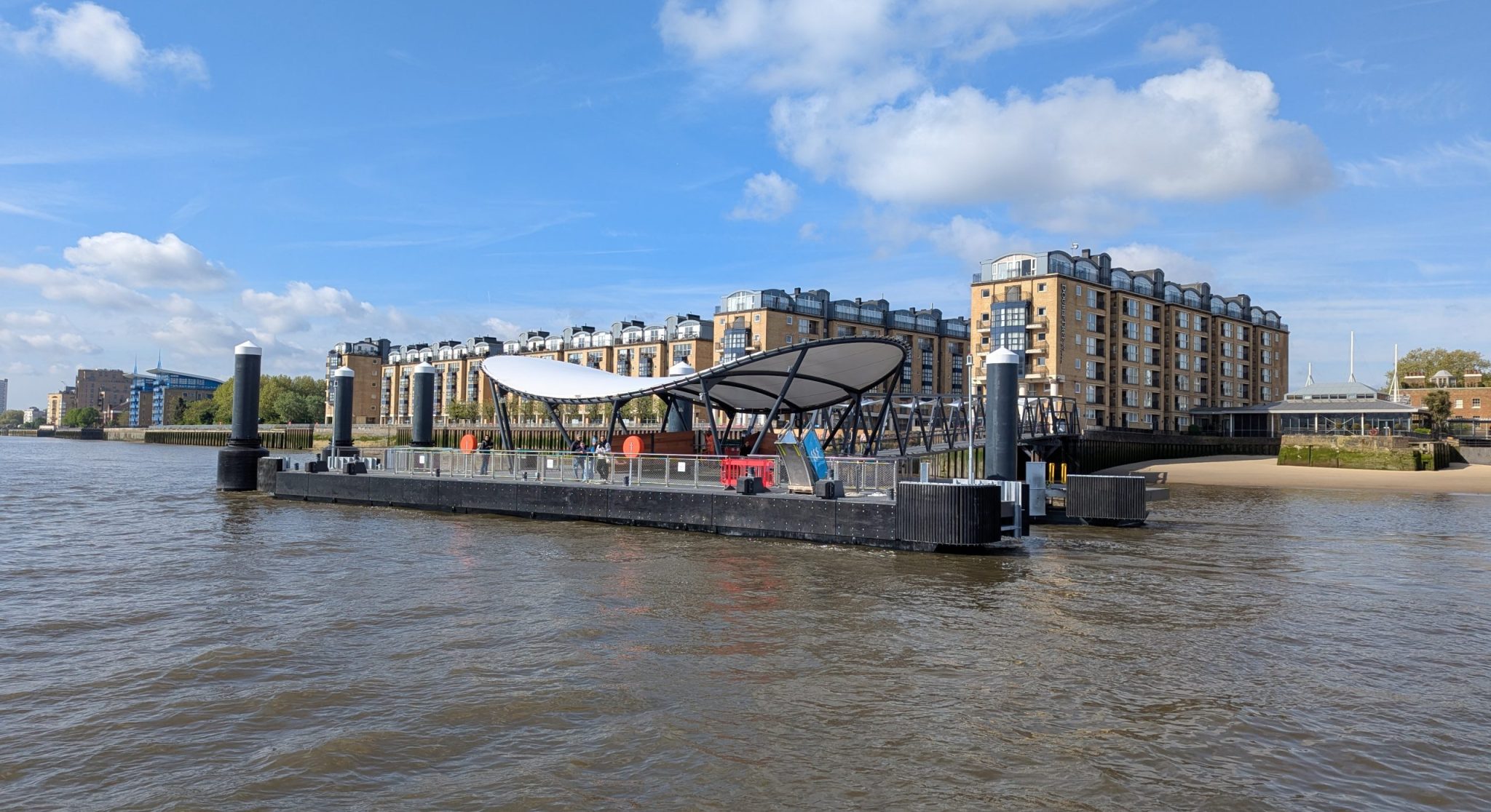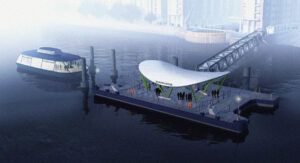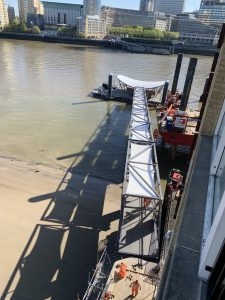
Zero emissions cross-river ferry
The Zero Emission Cross River Ferry project upgrades the existing River Thames ferry crossing between Rotherhithe and Canary Wharf, to meet a growing need for more accessible crossings for pedestrians and cyclists on the Thames.
The original pier, known as the DoubleTree Docklands Pier, was designed by Beckett Rankine in 1990 and had reached the end of its design life. It used a diesel vessel and required passengers to enter via the DoubleTree at Hilton hotel lobby.

In 2017, a report by TfL considered the Benefit/Cost Ratios for alternative crossings in this location, including a lifting bridge concept or an immersed tunnel; however, these concepts were deemed unfeasible due to the likelihood that they could exceed the available budget by millions.
Championing the ferry
Beckett Rankine joined forces with Thames Clipper to propose improvements to the existing ferry crossing, which would come in significantly under budget of the alternative schemes without compromising passenger capacity.
Thames Clippers, working alongside Wight Shipyard, developed a concept design for the Orbit Clipper, an electric, zero-emission ferry with cycle-on cycle-off capability. When deployed on this route, the new ferry will increase current passenger capacity by around 25% per annum.
Our joint proposal pairs their new ferry with an innovative pier design to provide regular, fast and safe journeys with minimal energy usage. The scheme is estimated to cost a fraction of the lifting bridge, and with lower operating costs.
The Rotherhithe to Canary Wharf zero-emission ferry project is part of the Clean Maritime Demonstration Competition Round 3 (CMDC3), which was announced in September 2022, part funded by the Department for Transport and delivered in partnership with Innovate UK.
This is in addition to the funding Beckett Rankine has committed to the scheme as part of our research and development programme.
Project outline
The project involved:
Beckett Rankine was appointed Principal Designer under CDM. We brought architect Anthony Carlile on board for the Rotherhithe pier design, exploring how to maximise accessibility for pier users and connect seamlessly with pedestrian and cyclist routes in the surrounding areas.
We also worked in conjunction with Eadon Consulting and Aqua superPower for the innovative semi-autonomous mooring and shoreside power infrastructure.

Accessibility, sustainability and innovation
The zero-emission ferry replaces the existing diesel vessel and joins Thames Clipper’s existing hybrid ferries, each cutting emissions by up to 90%.
As the first all-electric ferry service in the UK, the Rotherhithe-Canary Wharf crossing is a prototype for further services in East London.
The high-capacity pier has a new floating pontoon with shelter, mooring piles, berthing piles, bankseat, 62m brow and 12m fixed bridge. Due to low water spring tides, we moved the existing berth out towards the navigable channel, which also minimised the dredging required.
The brow has a gentle gradient to make the ferries accessible for cyclists and people using wheelchairs or other mobility aids.
In addition to enhancing the experience for these users, the ability to carry more cyclists also supports wider plans to deploy e-cargo bikes via the waterways. Coupled with the new e-ferries, this creates a more sustainable option for cross-river cargo transport.
The shoreside pathways and infrastructure layouts are also designed to enable greater connectivity with public access routes, removing the need for passengers to go via the hotel lobby to reach the pier.
The architectural vision and landscaping integrate the pier with its surroundings both practically and aesthetically. In particular, the walkway within the Old Nelson Dock is sympathetic to its listed status.


Rotherhithe Pier was installed in summer 2025 by Red7 Marine and Delphini Ltd.
On 5th December 2025, the Orbit Clipper sailed for the first time. The occasion was marked with a a ceremony attended by the Mayor of London, Sir Sadiq Khan, alongside project partners, stakeholders, and cyclists with the British Triathlon.
Award-winning concept
In April 2019, the project won the Impact in Transport category at the New Civil Engineer 100 Companies of the Year Award 2019. The award was granted due to the scheme’s ability to act as a catalyst for sustainable transport, with the judges highlighting its relatively low cost and focus on users.
